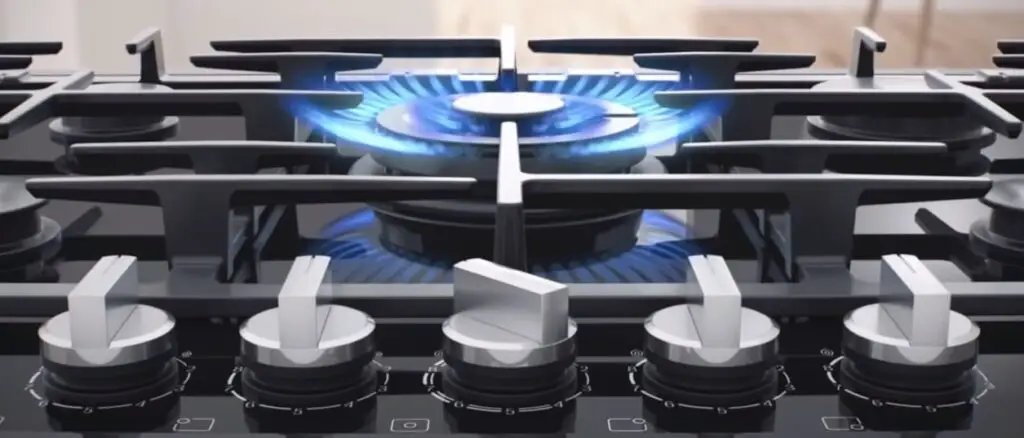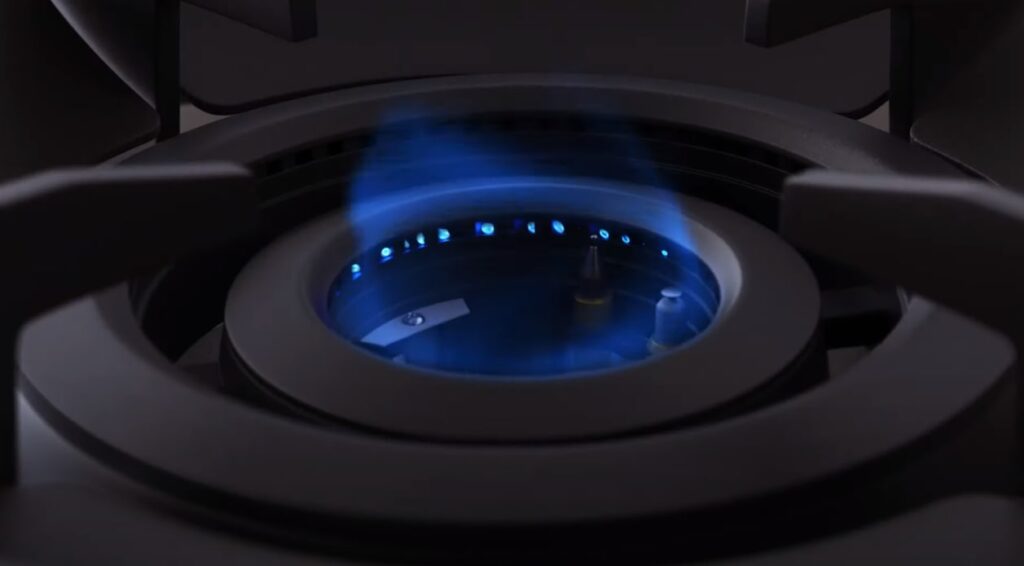
 Save Upto $850 ›
Save Upto $850 ›The Blue flames on gas stove means that your stove is working perfectly and efficiently and there is nothing to worry about.
Here we have discussed some considerations if you do not get blue flames on gas stove.
The significance of flame color might indicate temperature, fuel kind, or combustion completion.
It also defines the working and condition of your appliances and gives a signal whether the functioning is proper or not.
In other words, flame color plays a vital role when it comes to determining whether your stove is working properly or not. A blue flame is the hottest, followed by a yellow flame, then orange and red flames.
Wood, coal, and candles burn yellow, orange, or red, whereas hydrocarbon gases burn blue.The color of the flame varies as a result of the amount of oxygen and air supplied to it; this also affects the temperature. A simple example would be classroom bunsen burners.
Because the flame is receiving adequate oxygen, full combustion occurs with a blue flame. This results in less soot and a greater temperature.
An LPG flame burns at around 1,980 degrees Celsius during complete combustion.
The flame temperature of natural gas is roughly 1,960 degrees Celsius.
Blue flames typically indicate:
The more blue the hue of the fire, the healthier it is. This signifies that all of the chemicals are properly mixed and that the temperature is adjusted correctly.
The blue flames produced by liquefied petroleum gas (LPG) typically burn at roughly 3,600 degrees Fahrenheit.
The temperature of methane gas when burned with a blue flame is approximately 3,560 degrees Fahrenheit.
In comparison, the heat produced by orange and yellow flames is between 2,400 and 2,700 degrees Fahrenheit. The blue flames are far hotter.
When utilizing gas to cook and heat any liquid, the heat produced by blue flames is favored.
This is due to the longer time it will take to heat water or prepare food than it would with the orange or yellow flames that burn at cooler temperatures.
Tried everything and flames are still not blue then:
There must be some kind of combustion between the fuel and the air for a flame to form. Darker flames indicate more efficient combustion and hotter flames.
If your flame is anything other than blue, you’re probably wasting gas and the fire won’t be as clean. You will not waste gas if you verify that the combustion process is completed.
When you burn anything, you need fuel to start and keep a fire burning. Regardless of how long you want the fire to burn, you want to avoid wasting any fuel.
When the flame on the gas fireplace burns blue, as described above, combustion is taking place at the minimal level. That implies you’re utilizing the least amount of fuel for your gas fireplace.

A yellow or orange gas flame, or one that behaves with yellow or orange pops, indicates an incorrect oxygen ratio for combustion.
This type of faulty combustion is usually only transient and is caused by soot particles or a filthy burner that has to be cleaned.
A blue flame indicates that the gas has completely burned away.
Gas + Oxygen = Water + Carbon Dioxide + Heat
Incomplete combustion of the gas is indicated by a red, orange, or yellow flame.
Gas + Oxygen = Water + Carbon Dioxide + Carbon Monoxide + Heat
|
Flame Color |
Gas |
Temperature |
|
Blue |
LPG (Propane) |
1,980°C |
|
Blue |
Natural Gas (Methane Gas) |
1,960°C |
|
Yellow |
LPG / Natural Gas (Both) |
1,000 °C |
Simply said, a blue flame is far more secure for you and your property.
If you observe your flames blazing yellow, red, or with a yellow tip, you should have your appliance repaired as soon as possible since this is a typical warning indication.
Other red flags include eye discomfort, yellow/brown soot buildup, pilot lights blowing out, and a strange odor. These are all indications that incomplete combustion is taking place in your house.
The main exceptions are gas fireplaces and gas log fires, which are designed to create warm yellow or red flames.
Incomplete combustion wastes gas, which means you’re overpaying for energy. The greater issue is that carbon monoxide is being created, which is a severe home safety concern.
If you observe any of these issues, you should schedule a boiler service as soon as possible.
If you liked this article so far, then subscribe to our weekly newsletter and get the best of tips and tricks related to your stove directly into your inbox.
A natural gas flame should be blue, as this is the healthiest color to inhale. The absence of a natural gas blue flame or an LPG (propane) blue flame, and the presence of yellow or red flames instead, might indicate an appliance malfunction.
A gas fireplace should have blue flames, maybe with very faint yellow or orange points. The blue flame is considered as the perfect flame color. The flames should always be steady and constant.
Although red is typically associated with heat or danger, it also signals milder temperatures in flames.
While most people associate blue with cooler hues, it is the polar opposite in fires, indicating the fiercest flames.
When all of the flame colors mix, the color that results is white-blue, which is the hottest.
Blue denotes a temperature that is even hotter than white. Blue flames often erupt at temperatures ranging from 2,600° F to 3,000° F.
Because gases burn hotter than organic materials such as wood, blue flames have more oxygen and get hotter.
IS A BLUE FLAME ON A GAS STOVE DANGEROUS?
Blue flame means that your gas stove is working efficiently and it is also indicative that all the gases are mixing very well.
Blue flames are safe because they indicate that your gas-burning device is operating correctly and effectively.
Everything is combined properly and burning fiercely, as shown by the blue flame. Any flame that isn’t blue or violet gives out less heat.
A gas stove must reflect the blue flame. It is considered the perfect flame for your gas stove.
On gas appliances, a healthy, correctly burning flame should be blue, occasionally with a slight hint of yellow, and with a small light blue triangle in the middle.
This blue flame shows that the fuel combustion is safe, efficient, and complete. Whether it’s a gas stove, furnace, fireplace, or other equipment, you always want to see a blue flame.

Yellow or Red! A gas burner with yellow or red flames is harmful because it indicates incomplete combustion and the production of carbon monoxide (CO).
A yellow / red flame on a gas cooker is a severe safety issue if it occurs with a piece of interior equipment such as a gas stove.
The yellow / red color is caused by soot particles emitted by the flame. Yellow or red flames only burn at temperatures around 1,000 degrees Celsius. This flame is hazardous because it emits more deadly carbon monoxide gas.
A blue flame on a gas stove is more than Ok. This color also means that your stove is safe and good to cook your meal and there is nothing that you should worry about.
A blue flame indicates that full combustion is occurring. A yellow or red flame, or a gas flame color with a yellow burning tip, is a major warning indication that your gas appliance needs to be serviced.
Other signs include yellow/brown soot accumulating around the device, pilot lights that regularly blow out, an unpleasant odor, and eye discomfort.
A blue flame indicates that the gas has completely burned. LPG (Propane) burns with a blue flame when completely combusted. Pure hydrocarbons such as methane (refined natural gas), propane, butane, and ethane gases emit a blue flame as well.
Air and gas flow, which determines the quantity of carbon monoxide in the air, is one of the most important aspects that affect your gas appliances.
The color of the appliance’s flame is one of the most obvious signs that there is a problem and that servicing is required.
Hotter fires have more energy and different hues than colder ones. Although red is typically associated with heat or danger, it also signals milder temperatures in flames.
While most people associate blue with cooler hues, it is the polar opposite in fires, indicating the fiercest flames.
Burners that produce EXTREMELY high levels of carbon monoxide can burn blue. Burners that produce little carbon monoxide, on the other hand, can burn yellow. At low quantities, carbon monoxide is a colorless, odorless, tasteless, non-irritating, and very deadly gas.
If you notice orange, yellow, or red flames instead of blue flames, the burners may need to be cleaned or adjusted. The gas stove’s orange color serves as a warning that the combustion is improper and that dangerous volumes of carbon monoxide gas may be released (CO).
Yes! As narrated above, carbon monoxide emits a blue glow when burned. Carbon monoxide burns with a blue flame in the presence of oxygen, including ambient amounts, creating carbon dioxide. When nitrogen gas burns in the air, it creates water and has no color, odor, or taste.
Blue flames, which are hotter and more powerful than typical orange flames, can be created, shaped, and controlled by users. The color is a result of the extremely high temperatures and/or total combustion, which must have occurred at a temperature of at least 1,525°C (2,777°F).
Blue denotes a temperature that is even hotter than white. Usually, blue flames erupt when the temperature is between 2,600o F and 3,000o F. Because gases burn hotter than organic materials like wood, blue flames have more oxygen and are hotter.
So you now understand why a gas flame burns blue and why it is an issue if it does not. Keep an eye on your gas appliances and get them serviced as needed to ensure that they are working correctly and safely.
There is no need to worry about your gas stove if it is showing blue flames rather it is a good thing. However, if the stove is not showing that flame color then you should try to contact a professional or an expert to address this issue.
Also, follow the manufacturer’s instructions for maintenance service on a regular basis. Your family will be safer, and you will also save money.